Our Blog & Pet Health Topics
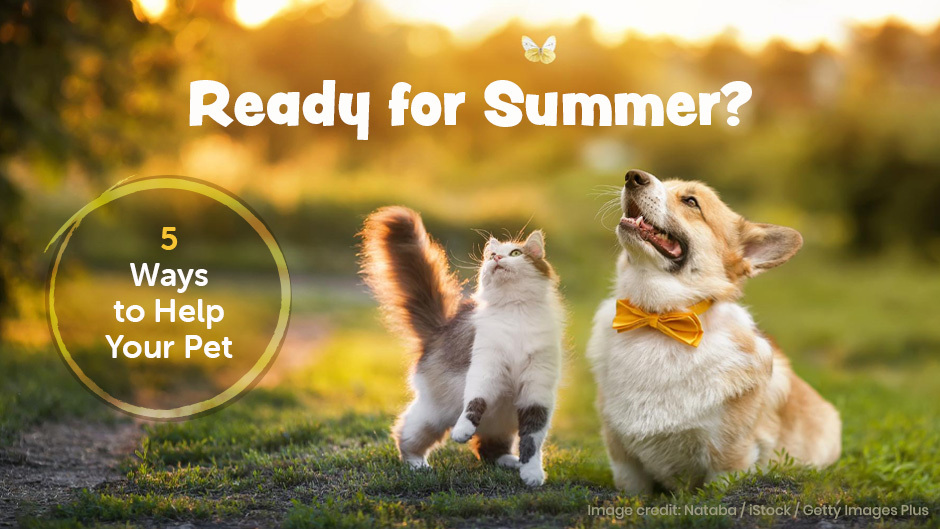
Ready for Summer? 5 Ways to Help Your Pets
Are you ready to enjoy warm summer days with your furry friend? With summer just around the corner, it’s essential to make sure you and your pets are prepared for some fun in the sun.
In this article, we’ll discuss five ways you can keep your pet healthy and safe this summer.
1. Preventatives
Preventatives are essential for keeping your pet healthy and happy all year long. During the summer months, many pets spend more time outdoors and are at greater risk of being exposed to mosquitos, fleas, and ticks. These insects can be a nuisance, but they can also carry disease and have a significant impact on your pet’s long-term health. Ensuring your pet is on the appropriate preventatives is an essential part of keeping your pet safe and reducing their risk of disease.
2. Pet ID and Microchips
While no pet owner wants to imagine their pet getting lost, pet identification can play a significant role in making sure your pet gets home safe.
One of the most common forms of identification is a name tag for your pet’s collar. When customizing your pet’s name tag, include contact information such as your phone number. This can be critical for helping people get ahold of you in an emergency.
If you are looking for a more permanent form of identification, microchips are a great option. Microchipping is a simple and pain-free procedure that can be performed during your pet’s routine wellness appointment. If your pet is lost, shelters and vet clinics can obtain your contact information from your pet’s microchip and help reunite you and your furry friend.
3. Prepare for “Booms”
From fireworks to summer storms, summer can mean more loud noises and sudden booms. For pets with noise phobias, it’s important to prepare for these events and provide your pet with some additional love and care.
If your pet has a noise phobia, pay close attention to your weather forecast and be mindful of holidays or other events where fireworks may be used. Some pets may also benefit from calming agents or medication to ease their fear and anxiety.
4. Know the Signs of Heat Exhaustion
As the temperatures rise, your pet’s risk of heat exhaustion increases. Heat exhaustion is extremely dangerous in pets and can be fatal if not properly treated. While reducing your pet’s exposure to extreme temperatures is critical, it’s also important to know how to recognize heat exhaustion in your pet. Some of the signs to look for include:
- Excessive panting
- Weakness or incoordination
- Vomiting or diarrhea
- Sudden collapse
If you notice any of these symptoms, please seek veterinary care immediately,
5. Lookout for Hot Spots
For many pets, warm weather can mean more hot spots. Hot spots are an inflammation of the skin and can turn into severe bacterial infections if not treated properly. If you notice your pet is excessively licking, examine the area for any redness or irritation. Getting your pet to stop licking is critical. However, you will also need to keep the area clean and dry. If the inflammation is severe or does not seem to be healing, please give us a call.
Final Thoughts
We hope this information will help keep your pets safe and prepare for blissful summer fun. If you have additional questions about preparing your pet for summer, please give us a call. We look forward to hearing from you and helping you keep your furry friends healthy and happy this summer.
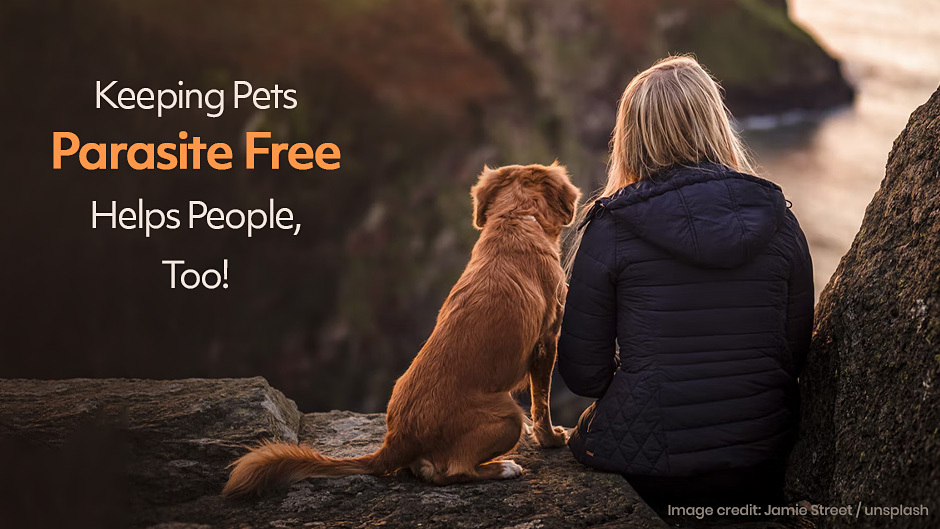
Keeping Pets Parasite Free Helps People, Too!
While parasite prevention is essential for your pet’s health, it can also play a critical role in keeping you and your family safe. Some of the parasites that affect pets can be spread to people.
In this article, we’ll discuss which parasites could be a risk to you and how to keep you and your pets parasite free.
Zoonotic Parasites
While many parasites can affect pets, zoonotic parasites can be transmitted from pets to people. Below are a few of the most common zoonotic parasites and what you need to know about them.
- Tapeworms
The most common zoonotic tapeworm is known as Dipylidium and is found in both dogs and cats. While you can not get this tapeworm directly from your pet, it can be spread by fleas. While it may seem unlikely that you would eat a flea, it can happen accidentally and is most commonly seen in children.
- Hookworms
Hookworms are another intestinal parasite that you can contract from your pet. Hookworm eggs can be excreted in your pet’s feces and live in the soil for long periods of time. When your skin comes in contact with contaminated feces or soil, the hookworm burrows into your skin. The infected area may become red and is often quite itchy.
- Toxoplasma
Toxoplasma is an intestinal parasite that is spread to humans through contact with cat feces. Symptoms of toxoplasma infection in people can vary but are usually mild and resemble the flu. However, pregnant women who become infected with Toxoplasma can spread the infection to their unborn children.
Keeping Your Pets Parasite Free
One of the most critical steps in keeping you and your pets safe is parasite prevention. Parasite prevention comes in various forms, including topical treatments, oral medications, and injectables. Some preventatives can protect your pet from multiple parasites. However, it’s essential to ensure your pet is fully protected from fleas, ticks, heartworms, and internal parasites.
If you have questions about your pet’s level of protection, our team is happy to provide recommendations and help make sure your pet is adequately protected.
In addition to preventative care, parasite testing is also critical. Fecal tests can detect intestinal parasites and are recommended during your pet’s annual wellness exam. You should also monitor your pet for any concerning symptoms such as weight loss, diarrhea, or excessive itch.
Reducing Your Risk
While keeping your pet parasite-free is critical, some additional measures can help reduce your risk. Always wash your hands before eating and after handling your pet. When your pet uses the bathroom, clean it up as soon as possible and always dispose of the waste properly.
Because of the increased health risks associated with Toxoplasma infection during pregnancy, the CDC recommends that pregnant women avoid cleaning their cat’s litter box when possible. Instead, ask another family member to help you with the task. If this is not possible, wear disposable gloves and wash your hands thoroughly when you are done.
Final Thoughts
Not only can parasite prevention protect your pet, but it can also help you! In addition to using parasite prevention, remember to be careful when cleaning up after your pet and always practice good hygiene.
If you have additional questions about keeping your pet parasite free, please give us a call. We are happy to set up an appointment to check your pet for parasites and discuss their preventative care.

Hidden Toxins in Your Home
Is your home a safe space for your pet? Unfortunately, many everyday items in your home can pose a significant risk to your pet’s health.
Here are a few dangers that may be lurking in your home and steps you can take to help keep your pet safe.
Cleaning Products
You probably spend plenty of time cleaning up messes in your home. Unfortunately, some of the ingredients in your cleaning products can be toxic to your pet. Some of these harmful ingredients include
- Bleach
- Ammonia
- Formaldehyde
- Chlorine
- Phenols
When using products with these ingredients, read the label carefully and follow the manufactures instructions regarding appropriate use and dilution.
While cleaning, it’s best to keep your pet out of the area. This will help limit your pet’s exposure and prevent your furry friend from getting into cleaning products while you’re not looking. When cleaning the toilet bowl, consider putting the lid down to reduce your pet’s risk of drinking the toilet bowl cleaner. Likewise, avoid spraying aerosols in your pet’s presence.
Not only can cleaning products be toxic if consumed, but they can also cause chemical burns. It’s best to avoid using harsh cleaning products in areas that your pet frequents. When you are done cleaning, make sure all cleaning products are safely stored out of your pet’s reach.
Plants
Whether they are in your home or around your yard, many plants and flowers can put your pet in danger. The ASPCA’s Toxic Plant Guide is a phenomenal resource for identifying dangerous plants in your home. Their site offers photos to help you identify the plant and discusses what kind of symptoms your pet may experience if exposed.
While removing toxic plants from your home is the best way to keep your pet safe, accidents can happen. If you believe your pet has consumed a toxic plant, please give us a call. We can help you decide what additional treatment may be necessary. If you are unable to identify the plant, a plant clipping or picture can help us determine an appropriate treatment plan and get your pet the essential care they may need.
Personal Care Items
Have you ever noticed your pet licking your lotion after you’ve applied it? From lotions to toothpaste, Personal care items are a commonly overlooked danger in your home. Even though you may not use these products on your pet, your furry friend may still be exposed to the toxic ingredients.
Lotions often contain artificial fragrances that can be irritating to your pet’s sensitive nose. Additionally, some lotions and creams contain medication, including anti-inflammatory agents, that can be toxic. When using these products, make sure you wash your hands thoroughly and avoid letting your pet lick any product off of your skin.
Another personal care item of concern is toothpaste. Xylitol is a common ingredient in human toothpaste and is extremely toxic to pets. Even if you’re not using your toothpaste to brush your pet’s teeth, it’s essential to be mindful of its potential danger and keep your toothpaste out of your pet’s reach.
Give Us a Call!
Identifying the hidden toxins in your home is an essential part of keeping your pets healthy and safe. If your pet is exposed to a toxin or is experiencing symptoms such as vomiting or lethargy, please give us a call as soon as possible.
We hope this information will help make your home a safer place for your furry friends.
Image credit: Mariakray/Pixabay
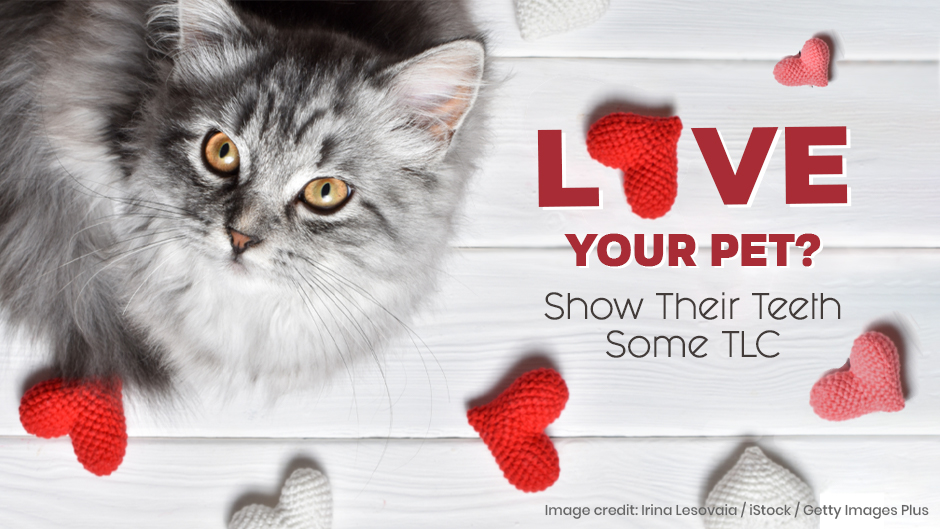
Love Your Pet? Show Their Teeth Some TLC
Are you looking for ways to show your pet some extra love this Valentine’s Day? While toys and treats are great, there is nothing better than giving your pet the gift of health. February is National Pet Dental Health Month and an excellent time to make your pet’s dental health a priority.
Here are a few ways you can improve your pet’s dental health and show their teeth some love all year long!
Benefits of Brushing Your Pet’s Teeth
Brushing your pet’s teeth does more than just improve their breath. According to the American Veterinary Medical Association, the majority of adult pets have some degree of dental disease. This condition is also known as periodontal disease and is caused by plaque and tartar buildup on your pet’s teeth. This buildup can spread below your pet’s gum line, causing gum inflammation and irritation.
As plaque and tartar accumulate, the amount of bacteria in your pet’s mouth will also increase. Not only is this bad for your pet’s oral health, but bacteria can also enter your pet’s bloodstream and spread throughout their body. This can have a significant impact on your pet’s long-term health.
The more frequently you brush your pet’s teeth, the better you can prevent the harmful repercussions of dental disease. Make sure you are using pet-friendly toothpaste. Not only does pet-friendly toothpaste come in a variety of tasty flavors, but they are also free of harmful ingredients that can be found in human products.
If you have questions about your brushing technique, let us know at your next wellness appointment. We can discuss your pet’s dental routine and how to make the process as stress-free as possible.
Trading Treats for Dental Chews
While treats can be delicious, they are not always the best for your pet’s health. This Valentine’s Day, consider trading out your pet’s high-calorie treats for healthy dental chews. Dental chews can help remove plaque while still serving as a tasty snack. Dental chews are not only a great option for a special Valentine’s Day treat, but they are also a great way to improve your pet’s dental health year-round.
When purchasing dental chews, look for products with a Veterinary Oral Health Council seal of approval. This means that the dental product has undergone a thorough review by veterinary professionals and is certified to improve your pet’s dental health. We are also happy to make recommendations based on your pet’s specific needs.
Schedule Your Pet’s Dental Cleaning
Do you know the last time your pet received a professional dental cleaning? At-home care is an important part of improving your pet’s oral health. However, professional care is still a necessity. We recommend that adult pets receive a dental cleaning approximately once a year.
These cleanings allow our veterinary team to remove all of your pet’s stubborn tartar, including the buildup that accumulates under the gum line. Professional dental cleanings are performed while your pet is under anesthesia. This helps keep your pet comfortable and allows us to perform a thorough cleaning.
Final Thoughts
We hope this article has given you some ideas on how you can improve your pet’s dental health. While February is a great time to show your pet’s teeth some extra TLC, it’s crucial to maintain healthy dental habits all year long. If you have additional questions about your pet’s dental care or would like to schedule an appointment, please give us a call.
Image credit: Irina Lesovaia / iStock / Getty Images Plus

8 New Year’s Resolutions for Pet Owners
It’s a new year, which means it’s a perfect time to reflect on the special bond you and your pet share. You love your pet. And they love you! Pets are treasured members of our families, so it just makes good sense to consider the year ahead and plan ways to help your pet stay in tip-top shape! Read on for 8 simple ways you can make your pet’s life even better.
1. See your home through your pet’s eyes.
From plants that may be toxic to household cleaners that could make them sick, trash containers out in the open, or medications within their reach, many of the things we don’t think twice about can be a real problem for pets. Take a moment to consider your home from your pet’s perspective and you’ll likely find all sorts of ways to remove potential hazards and keep your four-legged family member safe from their own curiosity.
2. Go outside with your dog on walks – it’s good exercise for both of you!
If you’re like many pet owners, your dog’s daily exercise is probably limited to a quick walk through the neighborhood. Consider making time for longer walks and play sessions. If you can’t, try hiring a dog walker or finding a doggy daycare in your area. Not only will your pet enjoy more time outdoors or being engaged in activity, you’ll be boosting their fitness levels too!
3. Get rid of that extra weight!
If your pet is overweight, it’s not just an aesthetic problem. Extra pounds put pets at risk for all sorts of serious conditions like arthritis, diabetes, heart disease and other significant illnesses. If you think your pet may be overweight, schedule an appointment with us to check them out. We’ll work together to set a reasonable goal for their weight loss.
4. Brush your dog or cat’s teeth regularly.
If you don’t already brush your pet’s teeth, now is a good time to start! Just as with humans, it only takes a few minutes each day and can help stop more advanced and complicated problems from developing.
Scheduling a professional cleaning with us will help us assess their dental health below the gum line, as well as what we can see when examining their mouth. Did you know that treating dental disease in its earliest stages not only helps keep your pet healthy, but is more economical than treating advanced dental disease? It literally makes “cents” to stay on top of your pet’s dental health.
As your pet’s veterinarian, we can also advise on dental treats, chews and rinses that will keep your pet’s mouth bright, healthy and smelling fresh.
5. Frequently clean food and water dishes that may be harboring bacteria.
If you notice slime (biofilm), cloudy or otherwise discolored water, or if food is left in the dish overnight, chances are good that bacteria is growing there. This can make your pet severely ill. Daily cleanings of their dishes followed by disinfecting in the dishwasher once a week will help them avoid this hazard.
6. Give them food that is appropriate to their age/weight/health needs.
Each year of a pet’s life brings special needs and concerns so it’s important to consider their age, weight, and health needs as you choose the best food for them. Unfortunately, there is so much marketing directed at pet owners about which foods to choose, it can be complex and overwhelming. We’re here to help you navigate the options and find food options that are best for your pet.
7. Schedule your pet’s wellness exam.
From vaccines to preventive medicine and parasite prevention to guide your pet’s journey as your pet ages, a wellness exam is a great way to keep your pet healthy and on track. We can help you learn more about their needs as they age, find ways to help them live longer and healthier lives, and identify problems in their earliest stages.
8. Spend more time with your pet.
Spending time with our pets is such a gift – why not commit to more of it? Not only will you make your pet happier, but it’s a great way to stay connected and strengthen the bond between you and your pet.
Have a happy 2022!
We hope you have a wonderful and healthy year ahead. We are here to help guide your pet’s journey in health and wellbeing, and we look forward to seeing you at our next visit!
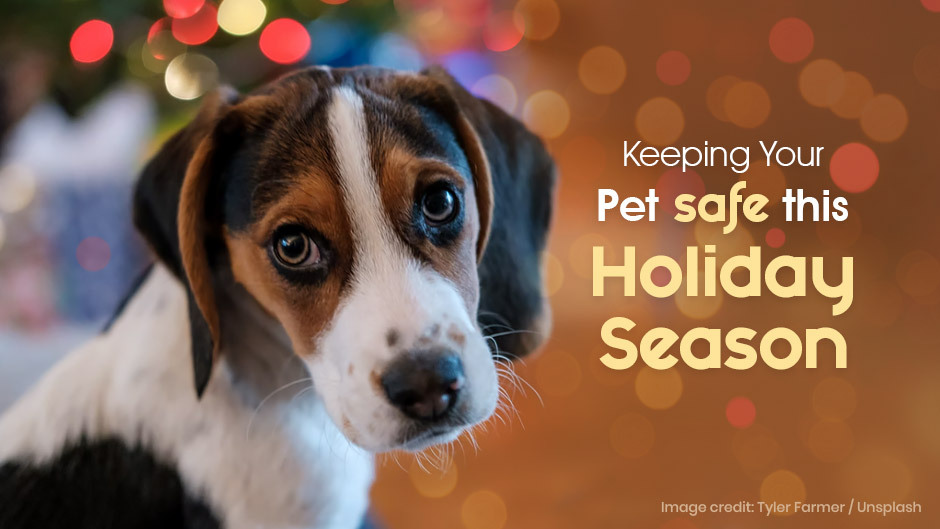
Keeping Your Pet Safe This Holiday Season
Celebrating the holidays with your pet is a wonderful gift. However, these celebrations can pose some potential risks to your pet’s health. Here are a few things you should keep in mind to help keep your pet safe this holiday season.
Dangerous Decorations
While holiday decorations are certainly beautiful, some decorations can be troublesome for your pet. One of the most common issues is pets consuming objects or materials that they shouldn’t. From sparkly tinsel to shiny ornaments, your pet may try to chew or swallow your holiday decorations. Not only can this cause digestive issues, but it can also be a choking hazard. Monitor your pet closely and try to keep decorations out of reach if possible.
If you are putting up a Christmas tree, there are some additional hazards you should be aware of. Cats frequently see Christmas trees as an exciting new object to climb. While you should discourage your pet from climbing the tree, it is always a good idea to make sure the tree is adequately secured just in case. This way, the tree won’t come toppling down in the event of a rogue tree climbing adventure.
If you are celebrating with a live tree, make sure you keep your pet from drinking the water out of the tree base. Tree water can contain fertilizer and bacteria that can be harmful to your pet. Also, be aware that other holiday plants like mistletoe and holly are dangerous and should be avoided.
Toxic Treats
As you celebrate the holidays, there will likely be plenty of tasty treats around your home. Unfortunately, many of these treats can be toxic to your pet. Some of the most common toxic foods include chocolate, raisins, grapes, onions, and garlic. Additionally, many sugar-free candies and baked goods contain an ingredient known as xylitol. Even small amounts of xylitol can be hazardous.
Try to keep tasty treats out of your pet’s reach and never leave food unattended. Remind your guests of your food rules and provide pet-friendly treats instead. If you are unsure if your pet has eaten something toxic, it is always best to give us a call or contact the Pet Poison Helpline.
Holiday Party Problems
Before you have your family and friends over for a holiday gathering, you should consider the impact a holiday party can have on your pet. Many pets experience anxiety with large groups of people in their homes. Creating a safe space where your pet can retreat from strangers can help reduce some of their stress. This space can be a quiet bedroom or another closed-off area of the house.
Creating a safe space can also help protect your pet from other dangers. With many people coming and going, doors are sometimes left open, and there may be more opportunities for your pet to escape. Try to keep your pet away from the door when people are coming and going. Also, ensure all doors are properly closed before letting your pet loose in the house.
Enjoy!
We hope you enjoy this wonderful time of year with the ones you love. Keeping your furry friends safe will ensure a joyous time is had by all!
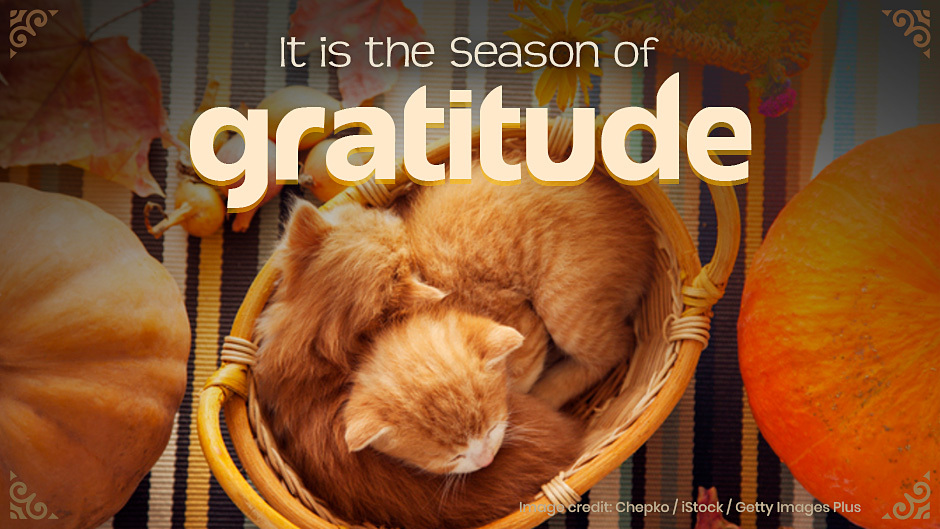
It is the Season of Gratitude
It is the season of gratitude! With Thanksgiving just around the corner, we would like to take the opportunity to thank you for allowing us to care for your precious pets, and share a few reasons why we are so grateful this holiday season.
For Patience
The past year and a half has definitely tested the patience of people around the globe. And, we see how the gift of your patience has impacted us – right here, and in our community. We appreciate the patience you’ve shown in longer wait times for appointments, curbside protocols and availability of appointment times. We understand it hasn’t been easy, and we appreciate the patience you’ve all demonstrated throughout this period of time.
For Your Kindness Toward Our Staff
Day in and day out, you demonstrate your gratitude toward our staff. You show gratitude for their expertise, compassion and dedication to the veterinary profession. From your words of thanks, to the treats you bring in for our team, to your kind words and positive reviews, never underestimate how it matters to us all. Our days can be long and filled with lots of emotion, and this takes a toll on our team members, especially when we may be short-staffed, or working long hours. These gestures you provide lighten the load we carry, and help us to continue offering our very best.
For Letting Us Be a Part of Your Pets’ Lives
We never forget that we are a part of your pets’ lives and wellness. We understand that the choice you make of veterinary care is an important one to you, and one that is not taken lightly. It is an honor to provide care for your pets throughout their lifetimes. Whether we meet your pet as a kitten or puppy, or we meet them as a senior while you’re continuing to provide the care they deserve into their golden years, or somewhere in between; we are grateful for the opportunity to be a part of your pet’s journey.
Have a Safe and Wonderful Holiday Season
We can’t thank you enough for allowing us to care for your precious pets. We are beyond grateful that you chose us as your veterinary family. We hope you have a holiday season that is filled with joy and extra time spent with those that are dearest to you. With the extra bustle, be sure to keep an extra eye on your curious pets – especially as holiday decorations and foods begin to make their appearance.
We wish you and your family all the best this holiday season!

3 Reasons We Appreciate Our Veterinary Technicians
The week of October 17-23 is wonder-fur! Why are we so excited? It’s National Veterinary Technician Week! And we love taking the opportunity to celebrate the hardworking veterinary technicians that make our practice the special place that it is. Are you curious about how our vet techs are vital to the care of your pet when you walk through our doors? Here are 3 reasons we love our vet tech and why you should, too!
1. Veterinary Technicians Get Your Pet’s Vital Signs
Our team of techs are often the first person you see in the exam room. They greet you and your pet, ask if there are any issues we need to know about, and take your pet’s vital signs. This includes taking stool samples, blood samples, and heart rate. They also give your pet a quick look over for any signs the vet may need to know about.
2. Veterinary Technicians Keep Your Pet Calm and Comfy During Their Exam
Vet techs often work as an extra set of hands during your pet’s exam. From holding a Great Dane still to cuddling a cat close enough to keep their claws tucked in, our vet techs keep pets and vets safe. This requires a lot of know-how, patience, and strength. In fact, most vet techs go through extensive schooling and are certified to assist veterinarians.
3. Our Veterinary Technicians Educate Pet Owners
When your pet isn’t feeling their best, it can be difficult to take in all the information you need to know. Thankfully, our techs have a knack for educating pet owners in an easy-to-understand way. This can include explaining:
- What your pet’s test results mean
- How to administer your pet’s medication
- Side effects to medicines
- How to prep your pet for surgery
- How to care for a pet’s wound or incision site once home
- What to expect for specific procedures, including surgeries
- Benefits and information regarding your pet’s behavior, diet, or prescriptions
Our team has extensive knowledge and experience, so they’re also able to answer questions pet owners have.
We’re Thankful for Our Awesome Team of Vet Techs!
While many of our team have been with us for many years, these past two years have been particularly challenging. Our vet techs have gone (and continue to go) above and beyond in the face of the pandemic. While others quarantined at home, our vet techs risked their health and worked tirelessly to care for pets.
It’s hard to imagine our veterinary practice without the helpful, compassionate, and knowledgeable care of our trusted vet techs–and we hope we never have to. If you have the opportunity, we hope you’ll express your gratitude for our vet tech team. We are grateful for them every day, but are happy to pay special tribute to them this week!
Image credit: Elladoro/Getty Images Plus
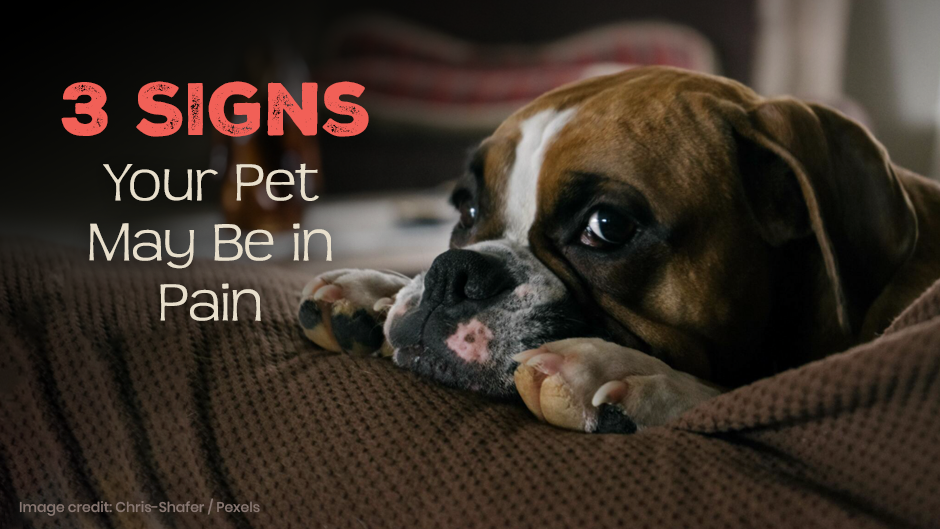
3 Signs Your Pet May Be in Pain
It crosses every pet owner’s mind: “Is my pet in pain?” And this question comes up more and more as our pets get older. One of the most difficult things about being a pet owner is that our pets cannot verbalize how they’re feeling. This leads us to wonder if our dogs and cats are living their best lives. The last thing you want is your pet struggling with chronic or acute pain, after all. And while your pet will likely never learn to speak human, they often send more subtle signs that they’re in pain. Here are 3 of the most common signs that your pet is in pain:
1. Changes in Behavior
It can be difficult to tell what is normal slowing down due to age for a dog or cat versus what is a change in behavior, activity level, or temperament due to pain.
What’s normal?
Partaking in games, affection, and fun but with less intensity. Many dogs and cats will also become more tired than they did when they were young. Sleeping more often between stints of activity is also normal.
What’s not normal aging?
If your pet’s attitude or interest in their favorite activities abruptly changes, there’s a very strong possibility they’re in pain. Discomfort and pain can make pets feel cranky and grouchy. It also zaps the fun out of playtime, snuggling, and receiving attention.
Many pets will tend to become more irritable over the course of the day. This is due to compounding aches and pains. There’s also a very good chance that if your pet is experiencing pain, they’re not sleeping well which adds to their crankiness.
Some pets may even growl or nip in response to pain. If you stroke your pet and they pull away or turn to nip you, you may have run your hand over a sore area.
If your pet loves snuggling on the sofa, but suddenly refuses to hop up, they’re likely not feeling their best.
2. Obsessively Licking One Area of the Body
Both dogs and cats will obsessively groom an area that is bugging them. The most obvious reason they do this is that they’re surveying and cleaning the area. Secondly, the tongue massages the tissues and increases blood flow to the area for a better immune response.
Not only does licking stimulate more blood flow to an area of discomfort, but it also releases ‘feel good’ endorphins in your pet’s brain.
You may notice your pet licking their paws and joints. This may be due to arthritis pain or over-exertion and soreness. Many dogs and cats will also paw at itchy painful eyes or ears.
3. Difficulty Eating or Lack of Appetite
If your pet loses interest in their meals, they are very likely not feeling well. Injuries can immediately cause a dog or cat to not want to eat. This is part of their fight or flight mentality as a response to pain.
Disinterest in food can be a sign of internal illness, as well. Many hidden conditions can cause a pet to feel lousy, which makes them lose interest in food. The most common internal conditions include:
- Parasites
- A strain or broken bone
- Allergies
- Tumors
- Infection
- Organ problems
- Possible poisoning
- An autoimmune disorder
Oral pain will also cause a reluctance to eat. If your pet skips a few meals or begins eating but stops, check their mouth for broken or chipped teeth. It can be difficult to tell what you’re looking at when it comes to your pet’s mouth, so be sure to make an appointment to see us.
Don’t Let Your Pet Continue to Deal with Pain
If you believe your pet may be in pain, please do not wait to schedule an appointment. Many of the signs we’ve listed could be symptoms of a worsening, severe, or life-threatening issue. We can diagnose your pet and provide the most advanced pain management and treatment.
Proactive preventative care, including dental cleanings, parasite prevention, exercise, regular checkups, and a healthy diet are the building blocks to your pet’s good health. We’re here to help you on this journey.
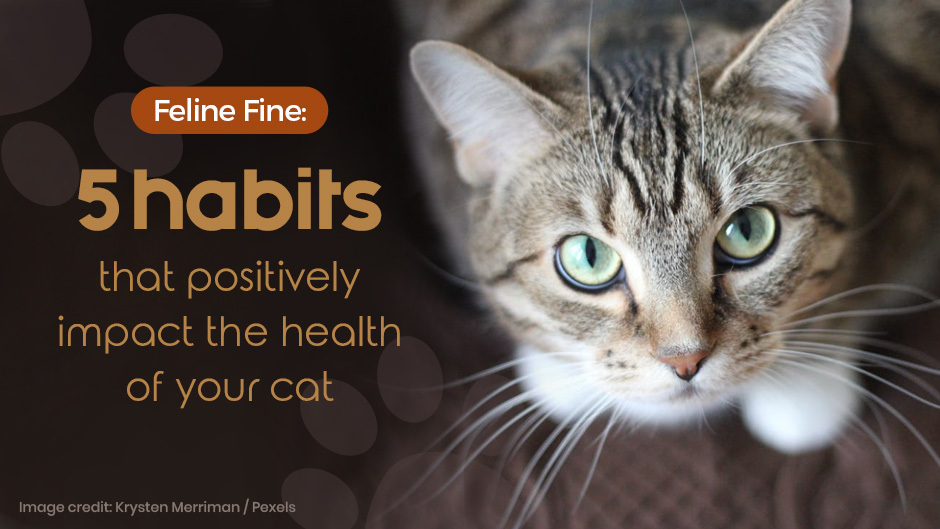
Feline Fine – 5 habits that positively impact the health of your cat
Cats are wonderful pets; in fact, over 25% of US households share their home with a feline companion, according to the AVMA (American Veterinary Medical Association). They’re cute, cuddly, comical, and provide delightful companionship! But there are some things you will want to keep in mind to keep your cat’s health in tip-top shape. Since August 22 is National Bring Your Cat to the Vet Day, we’re sharing 5 habits that positively impact the health of your cat!
1. Feed them a healthy diet
One of the best things you can do for your cat is to feed them a healthy diet. The diet should be high in quality and be appropriate for their overall health needs. For example, we offer diets that help support dermatologic issues, weight problems, sensitive stomachs, and provide overall support for your pet at whatever life stage they are in. You will want to avoid giving your cat junk food or table scraps, which will lead to an overweight kitty and affect their health.
2. Brush their teeth
Brushing your cat’s teeth is one of the easiest ways to support their health. Not only does brushing their teeth remove plaque buildup, but it also helps support healthy gums. Without brushing, periodontal disease can develop – and left to worsen, this can affect your cat’s internal organs, leading to costly illnesses.
Important tip: NEVER use human toothpaste to brush your cat’s teeth. There are toothpastes specifically for your feline friend, and even in flavors they’ll love!
3. Provide mental stimulation
Cats have active minds and a native instinct to hunt. If these two characteristics are not addressed, you may notice destructive behaviors in your cat, or possibly even boredom or depression. Food puzzles, foraging toys (which hide food inside), scratching posts, and vertical shelving for cats to get a “birds-eye view” can go a long way in keeping their minds engaged and their bodies active and healthy!
4. Be on the lookout for behavioral and health changes
There are some signs that can indicate your cat needs attention or medical care. If your cat is showing any of these signs, bring them to see us right away:
- Changes in activity level
- Changes in their appetite
- Hiding
- Signs of pain when touched or moved
- Weight loss
It’s important to note that cats are notoriously good at hiding pain and sickness, so subtle changes can help provide insight into issues that need to be addressed.
5. Remember to schedule their yearly veterinary visit
It is important that you bring your cat in for a yearly veterinarian visit. This ensures that they are up-to-date on their vaccinations and continue to get checkups to ensure that they remain healthy.
As we briefly mentioned before, cats hide illness and pain. Annual veterinary visits provide that nose-to-tail medical insight into changes that may have occurred over the past twelve months. As your cat’s veterinarian, we will check their weight, administer necessary vaccinations, complete any relevant lab work, and check the health of eyes, ears, skin, and teeth.
If your cat is a senior, more frequent visits, such as two times per year, are advised. Generally, cats become seniors around age 10, according to The American Association of Feline Practitioners.
We love seeing your cat!
All in all, there are many habits that will go a long way in keeping your cat healthy. We are here to partner with you in keeping your favorite feline happy, healthy, and part of your family for as long as possible! Give us a call to schedule your cat’s annual visit today!
